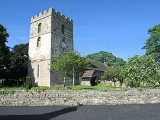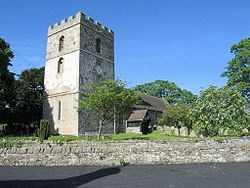
Cardington, Shropshire
Encyclopedia
Cardington is a village and civil parish in Shropshire
, England
. It is situated south of Shrewsbury
, near Caer Caradoc Hill
, and the nearest town is Church Stretton
. The parish also contains the villages of Enchmarsh and Plaish, and most of the parish is in the Shropshire Hills AONB
(Area of Outstanding Natural Beauty
).
the village is referred to as “Cardintine under the Fief of Rainwald Vicecomes” and it is mentioned that there were 11 leagues of woodland. Soon after that date the area had associations with the Fitzalans
, (ancestors of the Earls of Arundel) who gave Cardington and Lydley Hayes (or deer park
) to the military order of the Knights Templar
in about 1120 . The order was suppressed in 1308 and the lands involved reverted to the original donors.
Subsequent history is largely based on several important families that lived within the Parish
, some of whom started charities for the education of the young or for the provision of food for the poor. One example is the Old Free School which still stands next to the churchyard and was provided from a bequest in the will of William Hall in 1740 for the building of a schoolhouse and the maintenance of the schoolmaster.
and also the timber framed
barns that are common throughout the village. The old Free School is an early example of a brick building in this part of rural Shropshire.
The remaining listed buildings and most of the unlisted cottages date from between the early 18th and 19th centuries, the most ambitious of which is the old Vicarage on the western fringe of the village. The latter was built c.1814- 15 and is an accomplished piece of domestic design from the Regency period.
 The most important building in the village is the Church of St James (a grade I listed building), the nave of which dates from the Norman period
The most important building in the village is the Church of St James (a grade I listed building), the nave of which dates from the Norman period
. In plan it is typical of the simplest of churches from the Norman
period, consisting of a short rectangular nave
with a squat west tower. A chancel
was added in c.1300 in the form of a simple continuation of the nave. The linear character of the building is carried into the strong west tower, which rises
in three stages and is crowned by an embattled parapet. The top or belfry
stage was added in the 14th century. The fine timber porch was added in 1639.
Shropshire
Shropshire is a county in the West Midlands region of England. For Eurostat purposes, the county is a NUTS 3 region and is one of four counties or unitary districts that comprise the "Shropshire and Staffordshire" NUTS 2 region. It borders Wales to the west...
, England
England
England is a country that is part of the United Kingdom. It shares land borders with Scotland to the north and Wales to the west; the Irish Sea is to the north west, the Celtic Sea to the south west, with the North Sea to the east and the English Channel to the south separating it from continental...
. It is situated south of Shrewsbury
Shrewsbury
Shrewsbury is the county town of Shropshire, in the West Midlands region of England. Lying on the River Severn, it is a civil parish home to some 70,000 inhabitants, and is the primary settlement and headquarters of Shropshire Council...
, near Caer Caradoc Hill
Caer Caradoc Hill
Caer Caradoc is a hill in the English county of Shropshire. It overlooks the town of Church Stretton and the village of All Stretton and offers panoramic views to the north towards The Wrekin, east to Wenlock Edge, and west over the nearby Long Mynd...
, and the nearest town is Church Stretton
Church Stretton
Church Stretton is a small town and civil parish in Shropshire, England. The population of the town was recorded as 2,789 in 2001, whilst the population of the wider parish was recorded as 4,186...
. The parish also contains the villages of Enchmarsh and Plaish, and most of the parish is in the Shropshire Hills AONB
Shropshire Hills AONB
The Shropshire Hills area is designated as an Area of Outstanding Natural Beauty , in the English county of Shropshire, close to its border with Wales. Designated in 1958 , the area encompasses of land primarily in south-west Shropshire...
(Area of Outstanding Natural Beauty
Area of Outstanding Natural Beauty
An Area of Outstanding Natural Beauty is an area of countryside considered to have significant landscape value in England, Wales or Northern Ireland, that has been specially designated by the Countryside Agency on behalf of the United Kingdom government; the Countryside Council for Wales on...
).
History
In the Domesday BookDomesday Book
Domesday Book , now held at The National Archives, Kew, Richmond upon Thames in South West London, is the record of the great survey of much of England and parts of Wales completed in 1086...
the village is referred to as “Cardintine under the Fief of Rainwald Vicecomes” and it is mentioned that there were 11 leagues of woodland. Soon after that date the area had associations with the Fitzalans
FitzAlan (name)
FitzAlan is an English surname ultimately of Norman-Breton origin. The family originated in Brittany, in France, and shares common ancestry with the Scottish Stewarts as descendants of the eponymous Alan fitz Flaad grandson of the Seneschal of the Bishop of Dol. The FitzAlans held the earldom of...
, (ancestors of the Earls of Arundel) who gave Cardington and Lydley Hayes (or deer park
Medieval deer park
A medieval deer park was an enclosed area containing deer. It was bounded by a ditch and bank with a wooden park pale on top of the bank. The ditch was typically on the inside, thus allowing deer to enter the park but preventing them from leaving.-History:...
) to the military order of the Knights Templar
Knights Templar
The Poor Fellow-Soldiers of Christ and of the Temple of Solomon , commonly known as the Knights Templar, the Order of the Temple or simply as Templars, were among the most famous of the Western Christian military orders...
in about 1120 . The order was suppressed in 1308 and the lands involved reverted to the original donors.
Subsequent history is largely based on several important families that lived within the Parish
Parish
A parish is a territorial unit historically under the pastoral care and clerical jurisdiction of one parish priest, who might be assisted in his pastoral duties by a curate or curates - also priests but not the parish priest - from a more or less central parish church with its associated organization...
, some of whom started charities for the education of the young or for the provision of food for the poor. One example is the Old Free School which still stands next to the churchyard and was provided from a bequest in the will of William Hall in 1740 for the building of a schoolhouse and the maintenance of the schoolmaster.
Listed buildings
Cardington is a small rural village whose form, layout and overall size was already well established by the 14th century and which remains largely unchanged. There are several buildings that date from before 1600 including ‘The Barracks’, the Malster’s Tap (of c.1580) and its associated Longhouse. Several other buildings belong to the early 17th century including Manor Farm, Grove Farm, the Royal Oak public housePublic house
A public house, informally known as a pub, is a drinking establishment fundamental to the culture of Britain, Ireland, Australia and New Zealand. There are approximately 53,500 public houses in the United Kingdom. This number has been declining every year, so that nearly half of the smaller...
and also the timber framed
Timber framing
Timber framing , or half-timbering, also called in North America "post-and-beam" construction, is the method of creating structures using heavy squared off and carefully fitted and joined timbers with joints secured by large wooden pegs . It is commonplace in large barns...
barns that are common throughout the village. The old Free School is an early example of a brick building in this part of rural Shropshire.
The remaining listed buildings and most of the unlisted cottages date from between the early 18th and 19th centuries, the most ambitious of which is the old Vicarage on the western fringe of the village. The latter was built c.1814- 15 and is an accomplished piece of domestic design from the Regency period.
St James's Church

Norman dynasty
Norman dynasty is the usual designation for the family that were the Dukes of Normandy and the English monarchs which immediately followed the Norman conquest and lasted until the Plantagenet dynasty came to power in 1154. It included Rollo and his descendants, and from William the Conqueror and...
. In plan it is typical of the simplest of churches from the Norman
Norman architecture
About|Romanesque architecture, primarily English|other buildings in Normandy|Architecture of Normandy.File:Durham Cathedral. Nave by James Valentine c.1890.jpg|thumb|200px|The nave of Durham Cathedral demonstrates the characteristic round arched style, though use of shallow pointed arches above the...
period, consisting of a short rectangular nave
Nave
In Romanesque and Gothic Christian abbey, cathedral basilica and church architecture, the nave is the central approach to the high altar, the main body of the church. "Nave" was probably suggested by the keel shape of its vaulting...
with a squat west tower. A chancel
Chancel
In church architecture, the chancel is the space around the altar in the sanctuary at the liturgical east end of a traditional Christian church building...
was added in c.1300 in the form of a simple continuation of the nave. The linear character of the building is carried into the strong west tower, which rises
in three stages and is crowned by an embattled parapet. The top or belfry
Siege tower
A siege tower is a specialized siege engine, constructed to protect assailants and ladders while approaching the defensive walls of a fortification. The tower was often rectangular with four wheels with its height roughly equal to that of the wall or sometimes higher to allow archers to stand on...
stage was added in the 14th century. The fine timber porch was added in 1639.

